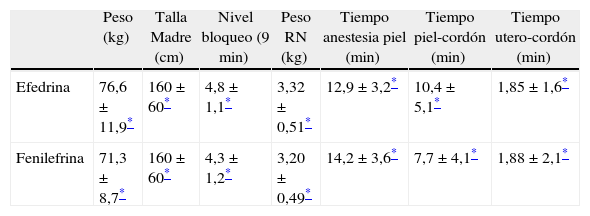La anestesia subaracnoidea para la cesárea conlleva una alta incidencia de hipotensión arterial, lo que puede obligar al uso de fármacos vasoconstrictores. El objetivo de este trabajo es comparar la eficacia de la efedrina (EFE) frente a fenilefrina (FENI) para prevenir la hipotensión secundaria, así como sus efectos sobre la madre y el recién nacido.
Material y métodosOchenta pacientes que iban a ser sometidas a cesárea electiva o urgente (sin dinámica uterina o riesgo de pérdida de bienestar fetal), fueron aleatorizadas en dos grupos que recibieron de forma profiláctica inmediatamente tras el bloqueo subaracnoideo: grupo EFE, efedrina en bolo iv 0,1 mg/kg más infusión continua a 0,5 mg/kg/h; grupo FENI, fenilefrina en bolo 1,5 µg/kg más infusión continua a 1,5 µg/kg/min. Se mantuvo la infusión hasta el pinzamiento del cordón y se registraron los parámetros maternos de: presión arterial, frecuencia cardiaca, presencia de náuseas, vómitos, mareo, bradicardia, hipo e hipertensión, y fetales índice de Apgar, y gasométricos pH, pCO2 y HCO3.
ResultadosLa incidencia global de hipotensión arterial fue 11,2%, 11,4% en el grupo EFE frente a 11,1% en el grupo FENI, sin diferencias significativas. Hubo mayor incidencia de hipertensión arterial y bradicardia en el grupo FENI frente a EFE (27,8 frente a 0% y 25% frente a 2,3% respectivamente). No hubo diferencias en la gasometría del cordón umbilical ni en el test de Apgar de los neonatos. La incidencia de hipotensión arterial una vez suspendida la infusión continua fue del 22,5% (72,2% grupo FENI frente a 27,8% grupo EFE).
ConclusionesEfedrina y fenilefrina, a las dosis estudiadas, han demostrado tener similar potencia para prevenir la hipotensión arterial durante la cesárea con anestesia subaracnoidea. El perfil de efectos secundarios mostró una mayor incidencia de hipertensión arterial y bradicardia en el grupo de fenilefrina. No hubo diferencias en los efectos neonatales.
Subarachnoid spinal anesthesia for cesarean section is associated with a high incidence of hypotension, which can require the use of vasoconstrictors. The aim of this trial was to compare ephedrine to phenylephrine for the prevention of secondary hypotension and to assess the adverse effects on both mother and newborn.
Material and methodsEighty patients undergoing elective or emergency cesarean section, in the absence of uterine activity or fetal risk, were randomized to receive prophylaxis with ephedrine or phenylephrine immediately after the spinal block. Patients in the ephedrine group received an intravenous bolus of 0.1 mg/kg plus continuous infusion at a rate of 0.5 mg/kg/h; patients in the phenylephrine group received an intravenous bolus of 1.5 µg/kg plus a continuous infusion at 1.5 µg/kg/min. Infusion was maintained until umbilical cord clamping. We recorded maternal blood pressure, heart rate, nausea and vomiting, dizziness, bradycardia, hypotension, hypertension, fetal Apgar index, and umbilical cord blood parameters (pH, PCO2, and HCO3).
ResultsThe overall incidence of hypotension was 11.2%, with no significant between-group differences (ephedrine group, 11.4%; phenylephrine group, 11.1%). The incidences of hypertension and bradycardia were higher in the phenylephrine group (27.8% and 2.3%, respectively) than in the ephedrine group (25% and 0%, respectively). Umbilical cord blood parameters and Apgar scores were similar. After suspension of continuous infusion, an episode of hypotension was detected in 22.5% of the patients (72.2% of these patients were in the phenylephrine group and 27.8% were in the ephedrine group).
ConclusionsAt the doses of ephedrine and phenylephrine administered in this trial, the ability of these drugs to prevent hypotension during cesarean section proved to be similar. Higher incidences of adverse events (hypertension and bradycardia) were observed in the phenylephrine group. No differences were observed in neonatal effects.
Artículo
Comprando el artículo el PDF del mismo podrá ser descargado
Precio 19,34 €
Comprar ahora










